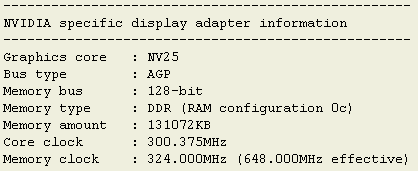System Setup and Overclocking
|
Intel Pentium 4 2.4GHz 'Northwood'
A.
Software
All benchmarks were conducted with vertical sync' disabled. Benchmarks were run 3 times consecutively, an average score was taken. The host system was configured for maximum performance. A fresh installation of Windows XP was used in both instances. We've chosen to pair up our two cards with, at the time of writing, arguably the most potent host CPU / memory combination currently available. It's only just that a top-end card should be benchmarked with other cutting-edge components. We've previously seen that both the Creative and MSI Ti4600s ran with an effective 660MHz memory clock, 10MHz higher than stated specification. Let's see if the ASUS continues the trend of factory overclocking.
In fact, if anything, the ASUS V8460 runs very slightly slower than stated memory clocks. Overclocking With a video card already as fast as the Ti4600, there seems to be little point in overclocking the card. Still, even if it is just from a curiosity point of view, we were intrigued to see what it could do. We tested the core by running the high dragothic test contained within 3DMark 2001SE. It's heavily GPU taxing, and is considered to be an excellent test for gauging potential GPU overclockability. Using Riva Tuner, we raised the GPU core speed from 300MHz in 5MHz increments and ran the dragothic test 5 times in a row to ensure basic stability. We arrived at a very stable speed of 318MHz core. 320MHz+ core would require the help of additional fans to be relatively stable. The extravagant looking cooling doesn't seen to aid overclocking greatly as we managed to reach 320MHz core with our reference cooler. We ran the lobby tests to check for memory overclockability. This time we started off at 700MHz memory (DDR) and raised the speeds in 10MHz increments. We found 740MHz to be the ideal, overclocked speed. Therefore, our stable, overclocked speeds are reflected by 318MHz / 740MHz clocks respectively. Even at 740MHz memory speed, the RAM was warm but not burning to the touch, we're not sure how beneficial extra heatsinks would have been. Perhaps it was wise not to include them and save on costs. We're sure that the overclocking potential will improve as yields slowly become better. |










